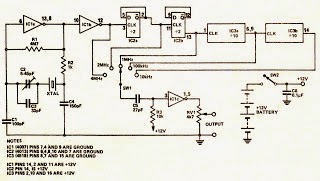Here are a Simple Electronic Schematic Circuit Project of Marker Generator. The marker generator circuit explained here is a constant- frequency oscillator driving into a CMOS divider chain. Switchable out- puts from the divider chain are selected to drive a pulse generator. The oscillator is C1a in which R1 biases the IC into linear operation. The crystal determines the basic frequency of operation at 4 MHz in conjunction with C1, 2, 3 and 4 which appear to the crystal as one parallel capacitor.
Simple Marker Generator Circuit Diagram:

The capacitor C2 is used to tune the oscillator exactly to frequency as explained in the text. The resistor R2 adds extra phase shift but also reduces the gain. Thus if the oscillator is slow in starting reducing R2 may help. The output of the oscillator is buffered from the rest of the circuit by IC1 /b. lC2 is a CMOS dual type D flip flop that divides the 4 MHz by four to provide an out put of 1 MHz, the 2 MHz also being brought out.
A further dual division by 10 is provided by lC3 which therefore provides outputs of 100 kHz and 10 kHz. The required output is selected by SW1 and applied to C5 and R3 which differentiate the square wave output of the divider. The waveform is then amplified and squared by IC1/c to provide an output train of narrow pulses, the amplitude of which may be varied by means of RV1.
Simple Marker Generator Circuit Diagram:

The capacitor C2 is used to tune the oscillator exactly to frequency as explained in the text. The resistor R2 adds extra phase shift but also reduces the gain. Thus if the oscillator is slow in starting reducing R2 may help. The output of the oscillator is buffered from the rest of the circuit by IC1 /b. lC2 is a CMOS dual type D flip flop that divides the 4 MHz by four to provide an out put of 1 MHz, the 2 MHz also being brought out.
A further dual division by 10 is provided by lC3 which therefore provides outputs of 100 kHz and 10 kHz. The required output is selected by SW1 and applied to C5 and R3 which differentiate the square wave output of the divider. The waveform is then amplified and squared by IC1/c to provide an output train of narrow pulses, the amplitude of which may be varied by means of RV1.
Comments
Post a Comment